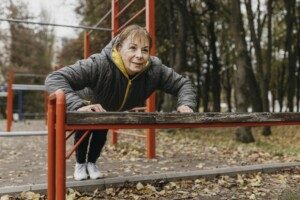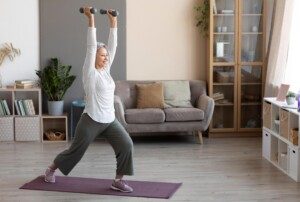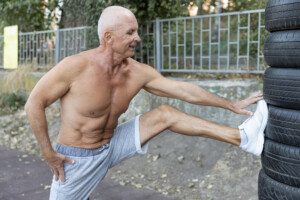Why do some senior age people use only the cardio machines at the gym and not do any strength training?
How much are they missing out in terms of health and fitness?
Use of cardio machines definitely has its solidly-affixed place in the realm of cardiovascular health.
Continuous walking, jogging, pedaling and stepping lead to a continuously elevated heart rate, which improves cardiorespiratory stamina and heart health.
But venturing into a gym to do only aerobic exercise is not enough.
Even if an older individual gets their aerobic exercise outdoors, such as with hiking long mountain trails, this should not be their only form of exercise.
Cardio Only? Not Enough for Elderly Bodies

Freepik.com
“I would say one of the biggest mistakes that elderly people make at the gym is only using cardio equipment like a treadmill or stationary bike,” says Dr. Megan McLain, PT, DPT, cofounder of Intuitive Choice Physical Therapy & Wellness in Atlanta, GA.
“It is extremely important to make sure that your workout is well-rounded and that you’re incorporating strength training, mobility training and balance training as well as cardio,” continues Dr. McLain.
“This can help decrease risk for falls and also combat the normal muscle and bone loss that gradually occurs with aging.”
The beauty of strength training or lifting weights is that it has a built-in provider of mobility and balance training.
For instance, if an older person holds a weight plate at their chest and lowers into squats for repetitions, this will not only boost bone density and muscle strength, but it will improve mobility and balance.
Overhead presses with dumbbells or a barbell will also improve mobility and balance.

Freepik.com
Though as mentioned, cardio machines have their place for heart health and stamina, you must also consider that they don’t always provide a realistic environment for ambulation.
A treadmill comes closest to this when compared to other cardio equipment, and walking or jogging on a treadmill without holding on will have carryover to walking in day-to-day life or trotting after the grandkids.
But other equipment such as the elliptical trainer and the stationary bike?
Sure, these will get your heart rate elevated, and fierce brief intervals of pedaling mixed with casual recovery pedaling will help burn excess fat.
However, they won’t do much for improving mobility and balance.
You may want to add three sets of squats or stationary lunges after your pedaling session.
But don’t stop there with the strength training. Have a seat on the leg press equipment and do three or four sets using a load heavy enough to make each set challenging.
Strength training not only makes your body stronger and sturdier, but it enhances the immune system and lowers the risk of type 2 diabetes.

Freepik.com
There’s no such thing as being too old to lift weights. Think of what you do every time you get out of bed in the morning: You’re lifting a weight – your body.
You lift this weight whenever you rise from a chair or go up a flight of stairs.
But the movements you do in the activities of daily living just aren’t enough.
You need to include a structured resistance training regimen in your life – along with the aerobic exercise.
“It’s important to take past injuries and other health conditions into consideration when designing your workout program though,” says Dr. McLain.
“Consulting a physical therapist or exercise physiologist is essential to make sure that you are training appropriately while taking those factors into account.”
What about the possibility of overtraining?
“You may need longer periods of recovery between sessions than you did when you were younger,” says Dr. McLain.
“The positive changes that we are looking for by using the gym and exercising actually occur when the body builds itself back between sessions.
“Being mindful of this is important. Also, making sure that you are not increasing weights or intensity of exercise too quickly is key.
“Pay attention to how you respond to a given activity and only change one of the following variables at a time.”
- The amount of time performing the activity
- The intensity with which you’re performing the activity
- The frequency of performing it.
“By not changing too much at once, you can prevent overtraining.”
 Dr. Megan McLain, PT, DPT, puts her clients first while providing one-on-one in-home care. With physical therapy and health coaching services, Dr. McLain addresses all aspects such as physical barriers, mindset, accountability and knowledge that may be impacting the client’s experience.
Dr. Megan McLain, PT, DPT, puts her clients first while providing one-on-one in-home care. With physical therapy and health coaching services, Dr. McLain addresses all aspects such as physical barriers, mindset, accountability and knowledge that may be impacting the client’s experience.
 Lorra Garrick has been covering medical, fitness and cybersecurity topics for many years, having written thousands of articles for print magazines and websites, including as a ghostwriter. She’s also a former ACE-certified personal trainer.
Lorra Garrick has been covering medical, fitness and cybersecurity topics for many years, having written thousands of articles for print magazines and websites, including as a ghostwriter. She’s also a former ACE-certified personal trainer.
.


























